
College of Pharmacy Professor Jaime Ross has discovered that cognitive decline occurs in a sex-dependent manner, mirroring patterns observed in humans.
Tiny fragments of plastic, known as microplastics and nanoplastics, are now so widespread in the environment that they regularly make their way into our bodies through the food we eat, the water we drink, and even the air we breathe. A new study from the University of Rhode Island’s College of Pharmacy reports that these particles can travel throughout the body, reaching organs such as the brain, where they may build up and contribute to conditions resembling Alzheimer’s disease.
This research builds on earlier work showing that microplastics are capable of passing through the blood-brain barrier, a natural defense system that usually shields the brain from harmful agents as tiny as viruses and bacteria.
Assistant Professor Jaime Ross extended the investigation to explore how these plastics affect brain function. Her team’s results suggest that the accumulation of micro- and nanoplastics in the brain may play a role in memory loss and cognitive decline, particularly in people with certain genetic risk factors for Alzheimer’s.
Testing Microplastic Exposure in Mice
Ross’ latest study, published recently in the journal Environmental Research Communications, examined mice that had been genetically modified to include the naturally occurring gene APOE4, a strong indicator of Alzheimer’s risk, making people 3.5 times more likely to develop the disease than those who carry the APOE3 variant of the gene that is passed from parents to offspring.

“In these mice, like in people, it’s not a guarantee that you’re going to see any changes in cognition. You could have identical twins both carrying APOE4, one totally cognitively healthy, and the other could develop Alzheimer’s disease,” Ross said. “So that tells us there’s something about lifestyle, something about the environment going on. There are modifiable factors we’re studying related to Alzheimer’s–diet, exercise, vitamins, and especially environmental toxins like microplastics. If you carry the APOE4, and you happen to consume a lot of microplastics, will this contribute to Alzheimer’s disease?”
To find out, Ross and her team exposed two groups of mice—one with the APOE4 variant and one with APOE3—to micro- and nanoplastics in their drinking water over a period of three weeks. The tiny particles from polystyrene—among the most abundant plastics in the world, found in Styrofoam take-out containers, plastic cups, and more—infiltrated the mice’ organs, including the brain, as expected. The research included a control group from each APOE designation did not receive microplastic exposure.
Ross’ team then ran the mice through a series of tests to examine their cognitive ability, beginning with an open-field test, in which researchers put a mouse in a chamber and allow it to explore at will for 90 minutes. Ordinarily, a mouse will hug the walls, naturally attempting to hide from potential predators. However, after microplastic exposure, the APOE4 mice—especially the male mice—tended to wander more in the middle of the chamber and spend time in open space, leaving themselves vulnerable to predators.
Behavioral and Memory Changes
To test their ability to recognize novel objects, Ross placed mice in an open chamber with two distinct objects. After having time to explore the objects, the mice were removed and returned later, this time with one of the objects replaced with a different shape.
The female mice with APOE4 and microplastic exposure were slow to recognize the novel objects, if they did at all, a sign of cognitive decline affecting memory.
“In the first test, you can see the males are spending more time and resting more in the center of the arena. In females, we saw changes in novel object recognition,” Ross said. “In human Alzheimer’s patients, men tend to experience more changes in apathy; they care less. Women experience more changes in memory. So the memory and the apathy connection are pretty clear: When you expose animals that are carrying the largest known risk factor in humans for developing Alzheimer’s disease to micro- and nanopastics, lo and behold, their behavior changes in a sex-dependent manner similar to the sex-dependent differences we see with Alzheimer’s patients.”
A Growing Environmental and Health Crisis
The results are concerning enough to warrant further study into the cognitive decline caused by exposure to micro- and nanoplastics, which are among the most prominent environmental toxins to which people are routinely exposed. (A separate URI study released in 2023 revealed of the extent to which microplastics accumulate in the environment, shockingly finding that the top two inches of the floor of Narragansett Bay contain more than 1,000 tons of microplastics.)
Ross is continuing to expand her research into the topic and encourages others to do so, in the hope of leading to better regulation of the toxins. The Microplastics Safety Act, introduced in the U.S. House of Representatives in July, would direct the U.S. Food and Drug Administration to study the human health impacts of microplastics in food and water, specifically focusing on vulnerabilities for children, the endocrine and reproductive systems, and links to cancer and chronic illnesses.
“There has not been a lot of money spent on the human health impacts of microplastics,” Ross said, noting she is in regular discussion with the Rhode Island Congressional delegation about the need for regulation. “It’s interesting that what we’re seeing in mice is similar to what we’re seeing in the real world. We want to encourage further research into the scourge of micro- and nanoplastics.”
Reference: “Short-term exposure to polystyrene microplastics alters cognition, immune, and metabolic markers in an apolipoprotein E (APOE) genotype and sex-dependent manner” by Lauren Gaspar, Sydney Bartman, Hannah Tobias-Wallingford, Giuseppe Coppotelli and Jaime M Ross, 20 August 2025, Environmental Research Communications.
DOI: 10.1088/2515-7620/adf8ae
Never miss a breakthrough: Join the SciTechDaily newsletter.
1 Comment
Junk Cleaner(64x) 2.01.2.2 CPS version